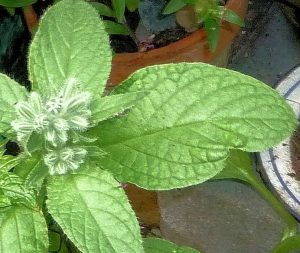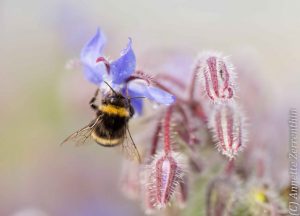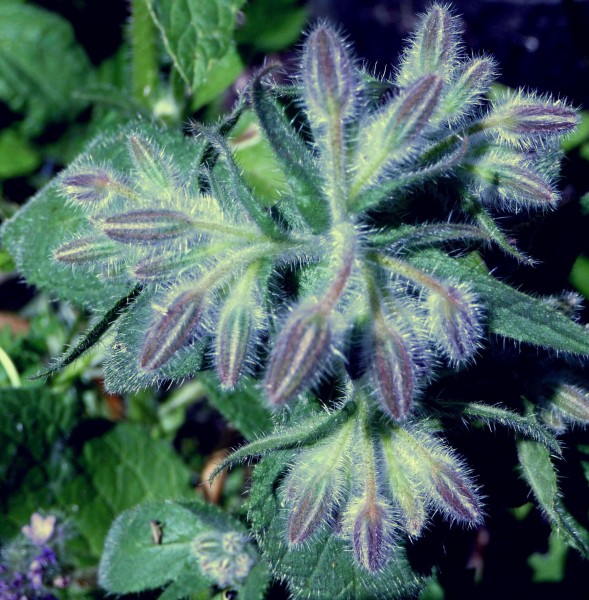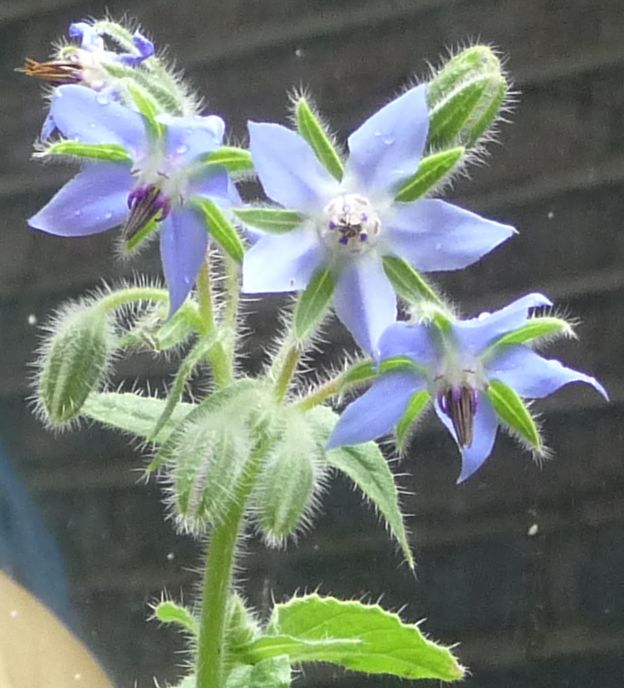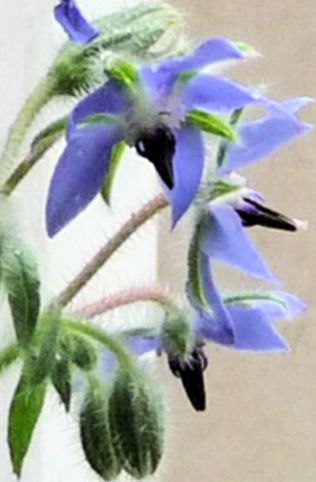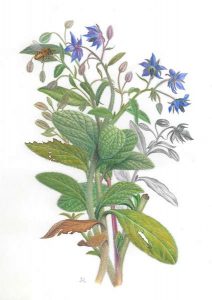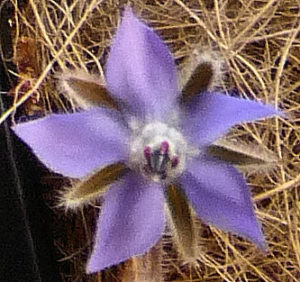BORAGE (Borago officinalis)
Syria
Borago officinalis is an annual herb from the Mediterranean, all parts of which are edible. In midsummer soft, furry buds of Borage open into bright BLUE starflowers which can bloom until September. In ordinary soil the plant may grow to three feet in height.
Borage increases the resistance of its neighbouring plants to pests & diseases. It can be propagated by seed or division, but bear in mind that it is a prolific self-seeder.
See http://permaculturenews.org/2011/01/21/all-about-borage/.
“June and July are heralded by the presence of the borage flower, an appealing, small, brilliant blue bloom with attracting qualities. Indeed, the plant should be included in the butterfly garden and brings pollinators to your veggies. The oval leaves are hairy and rough with the lower foliage pushing 6 inches in length. The borage plant may grow 12 or more inches wide in a tall bushy habit.”
Gardening Know How: Borage Herb: How To Grow Borage http://www.gardeningknowhow.com/edible/herbs/borage/borage-herb.htm
.
Bees Favourite
Honeybees, Wild Bees & Bumblebees (especially the 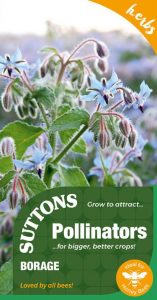 Yellow-marked garden and the Ginger-clad carder) so favour this wildflower that one of its other names is Bees-Bread.
Yellow-marked garden and the Ginger-clad carder) so favour this wildflower that one of its other names is Bees-Bread.
In a youtube video of bee-friendly flowers in his August garden, The Bumblebee Trust’s founder Dave Goulson says that Borage refills its nectar stores more quickly than any flower he knows.
Garden flowers for bees – august https://www.youtube.com/watch?v=ao_xGE2stnk&t=4s
Herbal and Medicinal The plant contains vitamins, minerals & carbohydrates. Leaves, flowers & oil of Borago officinalis have been used to treat conditions such as sore throats, coughs, allergies, depression & high blood pressure.
Historical
Borage is native to the Mediterranean, which is why it has such a long history of use dating back to ancient Greece. It was spread widely by traders throughout the Medieval period as well, bringing it to most of Europe and much of the Middle East. Modern trade introduced it to the US and Asia, where it thrives in many areas.
Everything you Need to Know about Borage Flowers – Petal Republic – Mozilla Firefox
“Borage is thought to derive from the Celtic borrach, or courage, for the plant was sacred to the Druids: weapons were consecrated with it before battle and their warriors prepared for the fray by drinking wine in which Borage had been steeped. Its virtue was recognised throughout the Classical world, for the Greeks and Romans used it similarly — Dioscorides and Pliny the Elder both acknowledged it. ” Ian Morton, Country Life. https://www.countrylife.co.uk/nature/borage-the-pimms-ingredient-that-powered-the-crusaders-and-lifted-dusky-melancholie-229439
“Those of our time do use the floures in sallads to exhilerate and make the minde glad.
There be also many things made of them, used for the comfort of the heart, to drive away sorrow, and increase the joy of the minde. The leaves and floures of Borrage put into wine make men and women glad and merry, driving away all sadnesse, dulnesse, and melancholy, as Dioscorides and Pliny affirme. Syrrup made of the floures of Borrage comforteth the heart, purgeth melancholy, and quieteth the phreneticke or lunaticke person.”
John Gerard in THE HERBELL, or GENERALL HISTORIE of PLANTES (1597), RHS Encyclopedia of Herbs and Their Uses, Demi Bown
In Floriography, The Victorian Language of Flowers, Borage is given the quality of ‘bluntness’.
Food and Drink
Throughout Europe, Borage has been used in food & drink. Its flavour was added to wines & vinegars, its plant tops put into soups & stews, with young leaves added to salads. The blue flowers have been candied & dropped into ice cube trays, later to be added to drinks for their cucumber-flavoured coolness.
Other Names: Bee Plant, Bee Bush, Bees-Bread, Borak, Borraja, Bugloss, Burrage, Common Bugloss, Cool Tankard, Devil in Church, Euphrosinum, Fleur de Bourrache, Granny’s Nightcap, Herb of Gladness, Lesan-el-Tour, Lisan Selvi, Ox’s Tongue, Talewort, Starflower.
Friends Andy & Jean & their girls moved to a beekeeper’s house near Hatfield Forest. The garden’s many bee-friendly flowers had been planted in rows, each one an island on its own with space all round it. Borage, however, was allowed to self-seed and grow where it liked.


